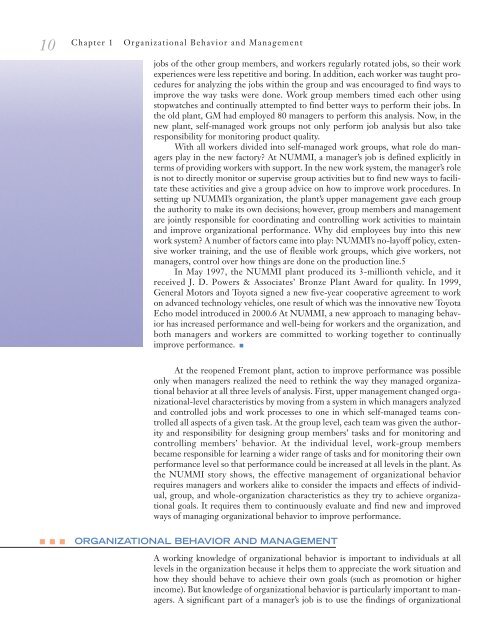chapter - Pearson
chapter - Pearson
chapter - Pearson
Create successful ePaper yourself
Turn your PDF publications into a flip-book with our unique Google optimized e-Paper software.
10<br />
Chapter 1 Organizational Behavior and Management<br />
jobs of the other group members, and workers regularly rotated jobs, so their work<br />
experiences were less repetitive and boring. In addition, each worker was taught procedures<br />
for analyzing the jobs within the group and was encouraged to find ways to<br />
improve the way tasks were done. Work group members timed each other using<br />
stopwatches and continually attempted to find better ways to perform their jobs. In<br />
the old plant, GM had employed 80 managers to perform this analysis. Now, in the<br />
new plant, self-managed work groups not only perform job analysis but also take<br />
responsibility for monitoring product quality.<br />
With all workers divided into self-managed work groups, what role do managers<br />
play in the new factory? At NUMMI, a manager’s job is defined explicitly in<br />
terms of providing workers with support. In the new work system, the manager’s role<br />
is not to directly monitor or supervise group activities but to find new ways to facilitate<br />
these activities and give a group advice on how to improve work procedures. In<br />
setting up NUMMI’s organization, the plant’s upper management gave each group<br />
the authority to make its own decisions; however, group members and management<br />
are jointly responsible for coordinating and controlling work activities to maintain<br />
and improve organizational performance. Why did employees buy into this new<br />
work system? A number of factors came into play: NUMMI’s no-layoff policy, extensive<br />
worker training, and the use of flexible work groups, which give workers, not<br />
managers, control over how things are done on the production line.5<br />
In May 1997, the NUMMI plant produced its 3-millionth vehicle, and it<br />
received J. D. Powers & Associates’ Bronze Plant Award for quality. In 1999,<br />
General Motors and Toyota signed a new five-year cooperative agreement to work<br />
on advanced technology vehicles, one result of which was the innovative new Toyota<br />
Echo model introduced in 2000.6 At NUMMI, a new approach to managing behavior<br />
has increased performance and well-being for workers and the organization, and<br />
both managers and workers are committed to working together to continually<br />
improve performance. ■<br />
At the reopened Fremont plant, action to improve performance was possible<br />
only when managers realized the need to rethink the way they managed organizational<br />
behavior at all three levels of analysis. First, upper management changed organizational-level<br />
characteristics by moving from a system in which managers analyzed<br />
and controlled jobs and work processes to one in which self-managed teams controlled<br />
all aspects of a given task. At the group level, each team was given the authority<br />
and responsibility for designing group members’ tasks and for monitoring and<br />
controlling members’ behavior. At the individual level, work-group members<br />
became responsible for learning a wider range of tasks and for monitoring their own<br />
performance level so that performance could be increased at all levels in the plant. As<br />
the NUMMI story shows, the effective management of organizational behavior<br />
requires managers and workers alike to consider the impacts and effects of individual,<br />
group, and whole-organization characteristics as they try to achieve organizational<br />
goals. It requires them to continuously evaluate and find new and improved<br />
ways of managing organizational behavior to improve performance.<br />
■ ■ ■<br />
ORGANIZATIONAL BEHAVIOR AND MANAGEMENT<br />
A working knowledge of organizational behavior is important to individuals at all<br />
levels in the organization because it helps them to appreciate the work situation and<br />
how they should behave to achieve their own goals (such as promotion or higher<br />
income). But knowledge of organizational behavior is particularly important to managers.<br />
A significant part of a manager’s job is to use the findings of organizational

















